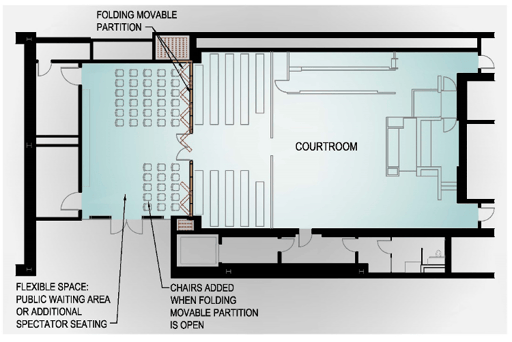As court operations are approaching a new normal, many court administrators and judges face questions about future space usage. Will virtual hearings and proceedings reduce the need for courtroom space? Will the transition to fully remote or hybrid work for court staff remain in place for the long term? Will more online payments and the use of kiosks reduce public contact and lessen the need for transaction counter spaces?
Courts must resolve these questions to address prospective new construction or renovation projects. One important lesson from the pandemic is that the future is unpredictable. With that in mind, the importance of flexible courthouse design that can be responsive to changing needs and circumstances is critical.
A court planner and architectural firm can benefit courts pursuing space projects now more than ever, with potential paradigm shifts in space utilization. Hiring a courthouse planning consultant can ensure that your space project is tailored to serve the court's specific needs while building flexibility for the future.
Flexible Courthouse Design Considerations
Some important considerations for a flexible courthouse design include:
- A courtroom design incorporating movable, flexible furniture and fixtures (e.g., attorney tables, spectator rail, and gallery seating) allows a court to easily move and position the furniture to meet changing requirements. The courtroom space can be easily reconfigured when the need arises.
- Movable walls in courtrooms provide flexibility in size. The courtroom wall behind the spectator area can be a folding movable partition, separating the courtroom from the public waiting area. The partition can be opened, and spectator chairs can be added when the court requires additional spectator seating.
This arrangement allows the waiting area to become part of the spectator seating. The courtroom can be utilized as a multi-purpose space or jury assembly area.
 Flexible courtroom
Flexible courtroom
- A flexible and adaptable office space design will allow your court to meet unpredictable and changing demands. Consider a floor plan with more innovative furniture than hard-walled offices.
- Furniture pods and de-mountable partitions can be used in court facilities instead of constructed enclosed spaces. Given the increasing trend toward more work-related conversations and meetings over the internet, open workstations should consider both spacing and partitions to provide more audio and visual privacy than were previously part of the open office design trend. Though the solution for each court component will be unique, an overall objective is to keep the furniture and fixtures as adaptable and flexible as possible.
Flexible Courthouse Design Best Practices
Best practices for designing flexible courthouse spaces that can adapt to changing demands include:
- Every courtroom, hearing room, and judge’s chambers should be able to perform videoconferencing. There is no doubt that videoconferencing technology will continue to evolve by incorporating enhanced reliability and security and will offer additional functionality. Courts that keep up with the changing technology can truly benefit.
- We recommend converting smaller spaces, such as hearing rooms and conference rooms that are too small to serve as fully functional courtrooms, into spaces that can serve as videoconference rooms for court proceedings. These spaces can be outfitted with videoconferencing equipment relatively easily and can then be dedicated for video arraignments, initial appearances, or other proceedings appropriate for videoconferencing.
- Courts should continue to modernize technologies and expand the use of online services. Implementing electronic filing, electronic payments, websites, and kiosks that provide access to information and forms were already in motion for many courts before the pandemic.
This technological push has allowed people who cannot come to court facilities to access court information and services. For people who come to the courthouse, technologies such as kiosks can add convenience for the public. Continuing this process is vital to future court operations.
A Courthouse Design That Endures
Whether your court is considering a new courthouse or planning a renovation within an existing courthouse, architects and court administrators make critical design decisions that may last a lifetime. By implementing the principles suggested in this article, a courthouse design that is responsive to changing needs and endures long into the future can be achieved.



.jpg)

.jpg)
.jpg)
.jpg)
.jpg)
.jpg)
.jpg)


-1.jpg)
.jpg)
.jpg)

